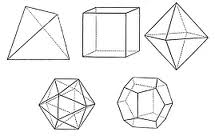 |
Craig White's Literature Courses Figures of Speech a.k.a. Figurative Language a.k.a. Tropes |
 |
Oxford English Dictionary: Figure: I. Form, shape.
In various uses, representing the technical applications of Greek σχῆμα. [>Latin figura]21. Rhetoric. a. Any of the various ‘forms’ of expression, deviating from the normal arrangement or use of words, which are adopted in order to give beauty, variety, or force to a composition; e.g. Aposiopesis, Hyperbole, Metaphor, etc.
Also, figure of speech.
[The intellectual or imaginative function of figures of speech may be comprehended as like the geometrical or visual-artistic meaning of figure:]
Oxford English Dictionary: 2. Geom. A definite form constituted by a given line or continuous series of lines so arranged as to enclose a superficial space, or by a given surface or series of surfaces enclosing a space of three dimensions . . .
 "stick figure" |
 "figure eight" |
By analogy, a figure of speech is like a picture, figure, or form in your mind.
![]()
Popular (or recognizable) figures of speech:
metaphor (+ analogy or simile)
irony (related terms: satire, wit, sarcasm, parody)
personification (a specific variety of metaphor)
hyperbole ("I'm drowning in busywork!" [w/ drowning as metaphor])
oxymoron ("She's awful nice.")
metonymy ("The White House said today . . . ";
synecdoche ("Hire 10 hands to dig this ditch"; "Many head of cattle have perished")
![]()
Why are they called Figures of Speech?
Dictionary.com: any expressive use of language, as a metaphor, simile, personification, or antithesis, in which words are used in other than their literal sense, or in other than their ordinary locutions, in order to suggest a picture or image or for other special effect.
Figure = picture, image, form, which makes a stronger impression on the mind than mere words. Non-figurative or literal language quickly comes to sound like data, just words. If you want someone to pay attention, use figures of speech.
Thus a figure of speech creates a form in the mind of the speaker or reader. With metaphor, the figure or form may be a corollary image ("She shone like gold."); with Hyperbole, an inflation or exaggeration (I've told you a million times, don't exaggerate.); with irony, a reversal or subversion of understanding ("The well-planned scheme failed completely.").
Tropes is another word for figures of speech. The term trope derives from the Greek tropos "turn, direction, way" . . . . "Trope" may be used when speaking with other literary scholars, but average people understand "figure of speech."
![]()
Literal and figurative language is a distinction in traditional systems for analyzing language.
-
Literal language refers to words that do not deviate from their defined meaning.
-
Figurative language refers to words, and groups of words, that exaggerate or alter the usual meanings of the component words. Figurative language may involve analogy to similar concepts or other contexts, and may involve exaggerations.These alterations result in figures of speech.
Potential problems with figures of speech:
-
Figures of speech are often idioms, which speakers of English as a Second or Other Language may find challenging.
-
Politicians use figures of speech when they want to catch people's attention and distinguish their speech and ideas from others'. For the same reason, figures of speech are risky. If everyone remembers what you said (e.g., "Read my lips: no new taxes") but then you have to change your mind, no one forgets as fast as if you'd spoken in gray, bureaucratic prose.
-
Figures of speech can be too hot or offensive. School communications, as in letters to angry parents or aggrieved students, use bland, bureaucratic prose. If you use a figure of speech, the angry or aggrieved party may pick it up and turn it back on you, whereas if you talk or write blandly, you don't give them anything to handle and they wander off.
Question: Why do terms for figures of speech look (or sound) so unfamiliar? (e.g., metaphor, metonym, synecdoche)
Answer: If the individual words or terms for tropes or figures of speech look strange or hard to pronounce, they're nearly all Greek in derivation, reminding us how much we owe the Greeks, whose language and civilization gave Western Civilization the study of rhetoric, poetics, philosophy, geometry (cf. hyperbole and hyperbola, below), architecture, democracy, drama, epic, sculpture, etc.
 |
 |
![]()
From About.com (Top 20 Figures of Speech): A figure of speech is a rhetorical device that achieves a special effect by using words in distinctive ways. . . .
Figurative language is often associated with literature—and with poetry in particular.
But the fact is, whether we're conscious of it or not, we use figures of speech every day in our own writing and conversations.
For example, common expressions such as "falling in love," "racking our brains," "hitting a sales target," and "climbing the ladder of success" are all metaphors--the most pervasive figure of all.
Likewise, we rely on similes when making explicit comparisons ("light as a feather") and hyperbole to emphasize a point ("I'm starving!").
Using original figures of speech in our writing is a way to convey meanings in fresh, unexpected ways. Figures can help our readers understand and stay interested in what we have to say. [i.e., writing should entertain and instruct.]
